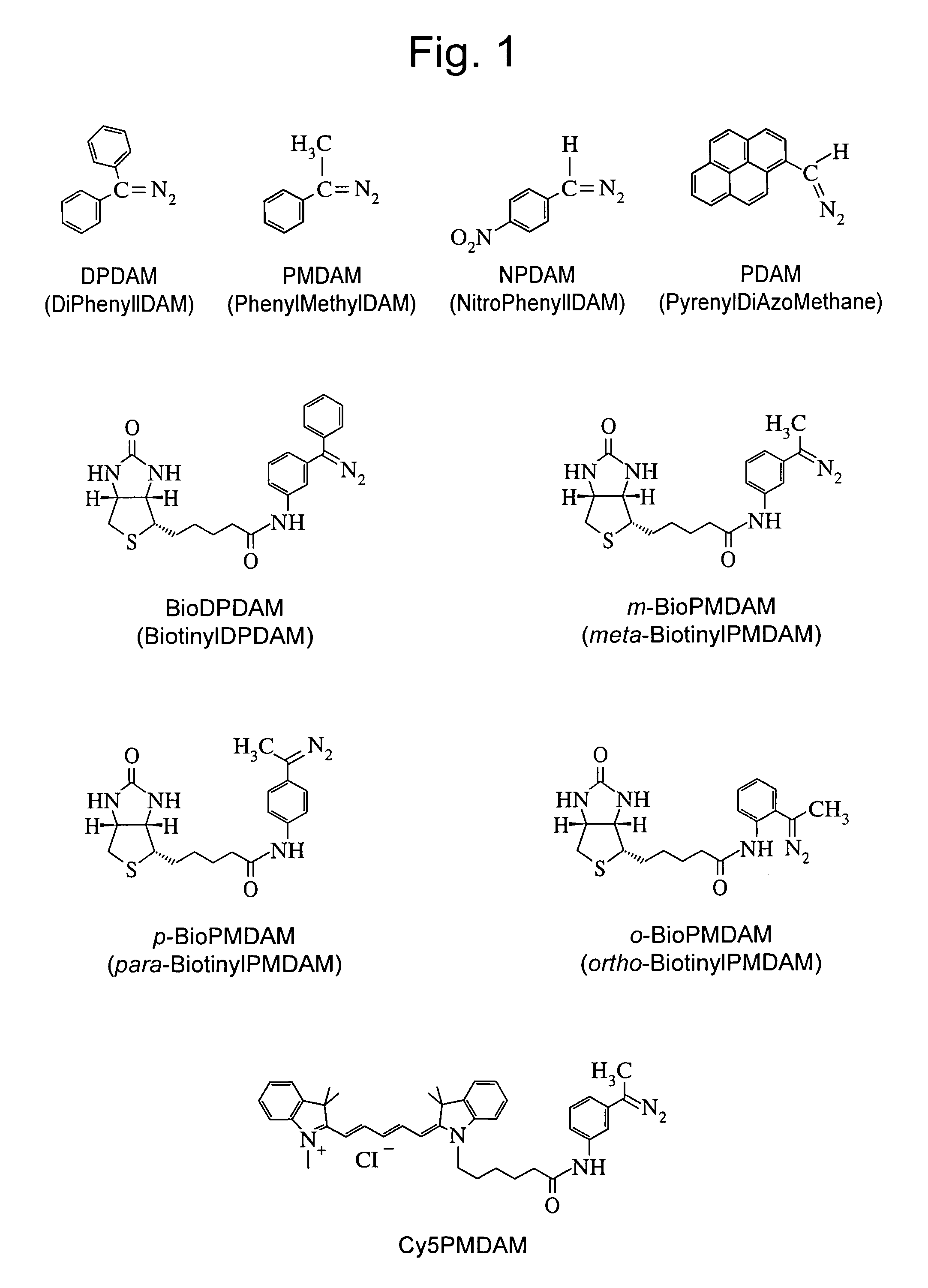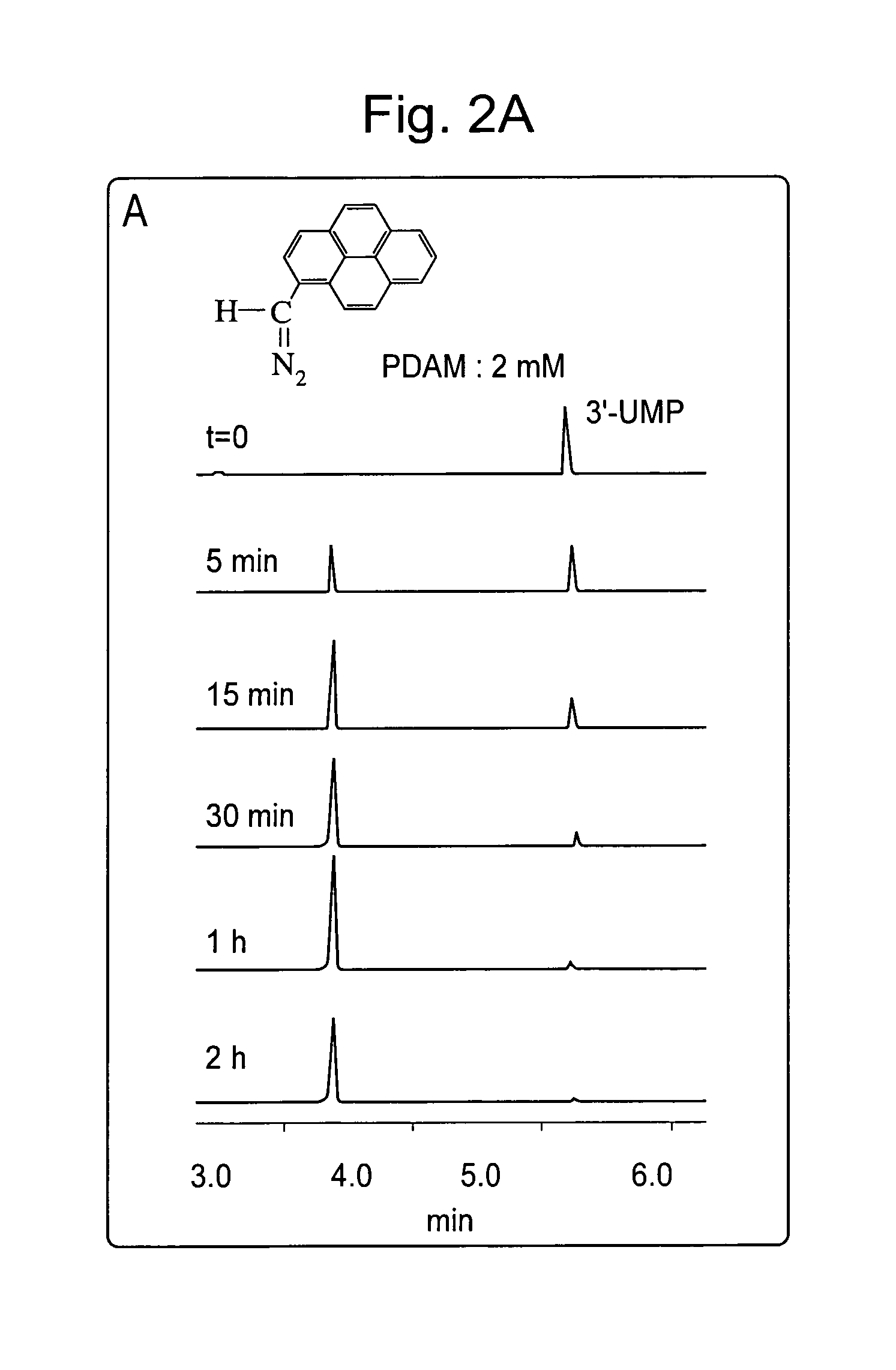Method for fragmenting and labeling DNA involving abasic sites and phosphate labeling
a phosphate labeling and dna technology, applied in the field of dna fragmentation and labeling, can solve the problems of lack of specificity between the nucleic acid and the nucleic probe, steric hindrance, and the labeling of nucleic acids especially for large-size nucleic acids, and achieve the effects of effective fragmentation of nucleic acids, easy generation of abasic sites, and increasing fragmentation
- Summary
- Abstract
- Description
- Claims
- Application Information
AI Technical Summary
Benefits of technology
Problems solved by technology
Method used
Image
Examples
example 1.1
Synthesis of Meta-BioPMDAM:
Compound biotin meta-acetophenone 1a:
[0213]The D-biotin (1.0 gram (g), 4.1 millimoles (mmol) is solubilized in 45 milliliters (ml) of anhydrous DMF in the hot state. The mixture is cooled to 0° C. under argon, and then N-methylmorpholine (590 microliters (μl), 5.33 mmol) and isobutyl chloroformate (840 μl, 6.60 mmol) are successively added. The mixture is kept stirred for 30 minutes (min), and then 3-aminoacetophenone (824 mg, 6.10 mmol) and N-methylmorpholine (480 μl, 4.35 mmol) in 10 ml of DMF are added. The solution is maintained stirred at 0° C. for 2 hours (h), and then evaporated to dryness. The residue is taken up in 3 ml of MeOH, and then 50 ml of water are added. The precipitate obtained is filtered, washed with water, CH2Cl2 and ether to give 1.2 g (80%) of crude product 1a. Recrystallization from the MeOH—H2O pair gives 1a (1.01 g, 70%) in the form of a white powder.
[0214]m.p. 145° C.—IR (KBr): 3280, 2931, 2857, 1691, 1590, 1540, 1487, 1434, 129...
example 1.2
Synthesis of Para-BioPMDAM
Compound biotin para-acetophenone 1b:
[0219]The D-biotin (1 g, 4.1 mmol) is solubilized in 45 ml of anhydrous DMF in the hot state. The mixture is cooled to 0° C. under argon, and then N-methylmorpholine (590 μl, 5.33 mmol) and isobutyl chloroformate (840 μl, 6.60 mmol) are successively added. The mixture is kept stirred for 30 min, and then 4-aminoacetophenone (824 mg, 6.10 mmol) is added. The solution is maintained stirred at 0° C. for 2 h, and then evaporated to dryness. The residue is taken up in 50 ml of water. The precipitate obtained is filtered, washed with water and then with 50 ml of MeOH in the hot state. The white precipitate is dissolved in DMF while heating and then the solution obtained is filtered and washed to with MnOH. The filtrate is recovered and evaporated to dryness to give 888 mg of 1b (2.46 mmol, 60%).
[0220]m.p. 260° C.—IR (KBr): 3260, 2930, 2358, 1706, 1673, 1610, 1526, 1401, 1380, 1322, 1257, 1150 cm−1.—1H NMR (200 MHz, DMSO-d6) δ=...
PUM
| Property | Measurement | Unit |
|---|---|---|
| pH | aaaaa | aaaaa |
| excitation wavelength | aaaaa | aaaaa |
| excitation wavelength | aaaaa | aaaaa |
Abstract
Description
Claims
Application Information
 Login to View More
Login to View More - R&D
- Intellectual Property
- Life Sciences
- Materials
- Tech Scout
- Unparalleled Data Quality
- Higher Quality Content
- 60% Fewer Hallucinations
Browse by: Latest US Patents, China's latest patents, Technical Efficacy Thesaurus, Application Domain, Technology Topic, Popular Technical Reports.
© 2025 PatSnap. All rights reserved.Legal|Privacy policy|Modern Slavery Act Transparency Statement|Sitemap|About US| Contact US: help@patsnap.com



